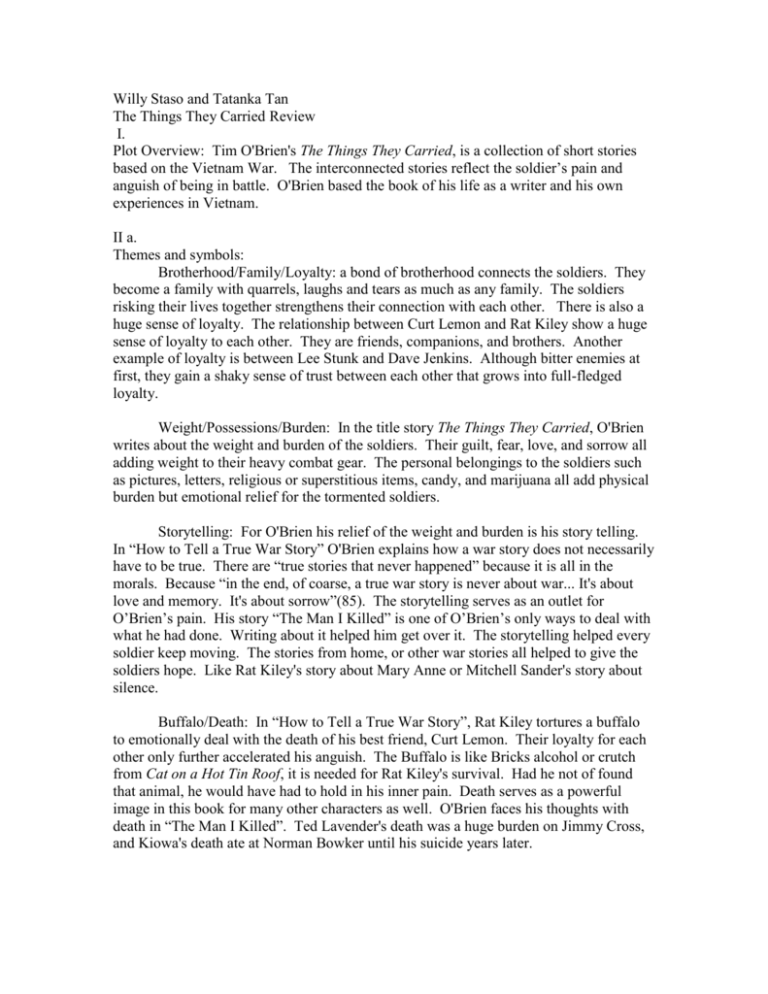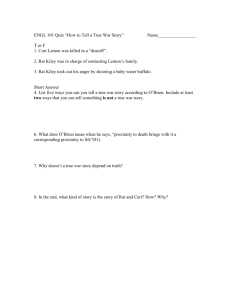Willy Staso and Tatanka Tan
advertisement

Willy Staso and Tatanka Tan The Things They Carried Review I. Plot Overview: Tim O'Brien's The Things They Carried, is a collection of short stories based on the Vietnam War. The interconnected stories reflect the soldier’s pain and anguish of being in battle. O'Brien based the book of his life as a writer and his own experiences in Vietnam. II a. Themes and symbols: Brotherhood/Family/Loyalty: a bond of brotherhood connects the soldiers. They become a family with quarrels, laughs and tears as much as any family. The soldiers risking their lives together strengthens their connection with each other. There is also a huge sense of loyalty. The relationship between Curt Lemon and Rat Kiley show a huge sense of loyalty to each other. They are friends, companions, and brothers. Another example of loyalty is between Lee Stunk and Dave Jenkins. Although bitter enemies at first, they gain a shaky sense of trust between each other that grows into full-fledged loyalty. Weight/Possessions/Burden: In the title story The Things They Carried, O'Brien writes about the weight and burden of the soldiers. Their guilt, fear, love, and sorrow all adding weight to their heavy combat gear. The personal belongings to the soldiers such as pictures, letters, religious or superstitious items, candy, and marijuana all add physical burden but emotional relief for the tormented soldiers. Storytelling: For O'Brien his relief of the weight and burden is his story telling. In “How to Tell a True War Story” O'Brien explains how a war story does not necessarily have to be true. There are “true stories that never happened” because it is all in the morals. Because “in the end, of coarse, a true war story is never about war... It's about love and memory. It's about sorrow”(85). The storytelling serves as an outlet for O’Brien’s pain. His story “The Man I Killed” is one of O’Brien’s only ways to deal with what he had done. Writing about it helped him get over it. The storytelling helped every soldier keep moving. The stories from home, or other war stories all helped to give the soldiers hope. Like Rat Kiley's story about Mary Anne or Mitchell Sander's story about silence. Buffalo/Death: In “How to Tell a True War Story”, Rat Kiley tortures a buffalo to emotionally deal with the death of his best friend, Curt Lemon. Their loyalty for each other only further accelerated his anguish. The Buffalo is like Bricks alcohol or crutch from Cat on a Hot Tin Roof, it is needed for Rat Kiley's survival. Had he not of found that animal, he would have had to hold in his inner pain. Death serves as a powerful image in this book for many other characters as well. O'Brien faces his thoughts with death in “The Man I Killed”. Ted Lavender's death was a huge burden on Jimmy Cross, and Kiowa's death ate at Norman Bowker until his suicide years later. II b. Key characters: -Rat Kiley: -Medic for Tim O’Brien’s unit, later on got replaced by Bobby -His good friend Curt Lemon died, after that he was never the same, in many ways Rat Kiley was like Brick in Cat on a Hot Tin Roof after Curt Lemon died went into depression and later on was transferred out of their unit -Directly after Curt Lemons death Rat Kiley entered a phase like Brick both of them very destructive Brick harms his family while Rat Kiley harms the baby buffalo -Norman Bowker: -Had a whole chapter dedicated to him, “Speaking of Courage” -Norman Bowker is where we really get to see the depression that comes with being a Vietnam Vet -Norman Bowker feels he needs to tell some one of how he didn’t get the Silver Star, but it was more then just telling them how he didn’t get the Silver Star. He needed to finally tell someone of Vietnam -Through out the whole chapter “Speaking of Courage” Norman Bowker goes through his head of what the conversation would be like he “imagined the feel of his tongue against the truth.”(142) To Norman Bowker he needed to tell this polite little town the truth of the war. He needed to get the war off his chest -Norman Bowker in some ways is like Pecola from The Bluest Eye as in they both had so much dislike put on them by society and they both have no way of telling anyone and getting this weight off their chest so eventually the society destroyed both Norman Bowker and Pecola -Mary Anne: -Shipped in to Vietnam to see boyfriend (Mark Fossie) very pretty/innocent -Very Curious about Vietnam wants to learn about it and be a part of it -Starts disobeying Mark Fossie and goes on Missions with the Greenies (special forces) begins to become a part of the jungle going on dangerous raids and begins losing her mind. -This story ends hinting that Mary Anne has become a part of Vietnam its self -Tim O’Brien: -As well as being the author of this book he is also a character in the novel -“On The Rainy River” is were O’Brien goes into what he felt before joining the Vietnam War and his thoughts when he received his draft card -He goes into his attempt to escape the draft and his time spent with that old man who, with out being told, knew what O’Brien was running from and gave him the help he needed -Tim O’Brien ends the chapter with “I survived, but it’s not a happy ending. I was a coward. I went to the war.” Tim O’Brien is always mentioning things about courage and what it means to be courageous. -Linda: -Seen only in the last chapter, she was Tim O’Brien’s friend who got cancer and died at an early age - Linda represents all of Tim O’Brien’s love, sadness, and all his friends lost in combat -Linda prepared Tim O’Brien for war in a sense; Linda made Tim O’Brien experience pain, sadness, and love all which Tim O’Brien incorporates with war -Jimmy Cross: -Commander of Tim O’Brien’s platoon -Feels incredibly responsible for all of his men -In love with Martha, but Martha will never love him the way he loves her III. Significant Passages A) Page 78-79 “He stepped back and shot it through the right front knee… Later in the week he would write a long personal letter to the guy’s sister, who would not write back, but for now it was a question of pain.” -Love that Rat Kiley had for Curt Lemon -The Courage Rat Kiley possessed -The life in the water buffalo’s eyes B) Page 2-3 “The things they carried were largely determined by necessity… In April, for instance, when Red Lavender was shot, they used his poncho to wrap him up, then to carry him across the paddy, then to lift him into the chopper that took him away.” -The weight and pressure that each solider had to hump through daily -The Love for their valuables C) Page 142 “Norman Bowker smiled. He looked out across the lake and imagined the feel of his tongue against the truth. ‘Well, this one time, this one night out by the river…I wasn’t very brave.’” -Idea of Courage: The courage to speak/not having courage at some points D) Page 170-171 “He pictured Kiowa’s face. They’d been close buddies, the tightest…He’d lost Kiowa and his weapon and his flashlight and his girlfriend’s picture. He remembered this. He remembered wondering if he could lose himself.” -An impossible battle (trying to pull him up from his boot) -The horrors of Vietnam all in one shit field IV. Essay Questions: How is Tim O’Brien’s sense of Courage similar or different to the other authors we read this year? How do the burdens and weight of the soldiers reflect their actions? How do their personal belongings, memories, and feelings affect their judgments? Discuss one character and the things they carried with them to war. Give information on their emotions, thoughts, and beliefs and how their weight affects them overall.








